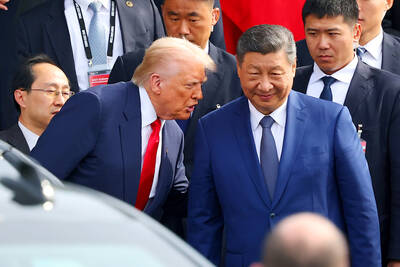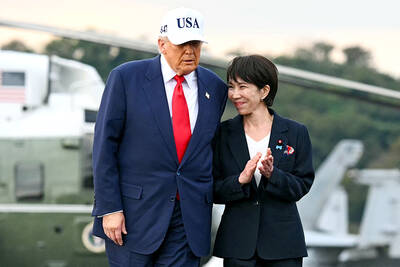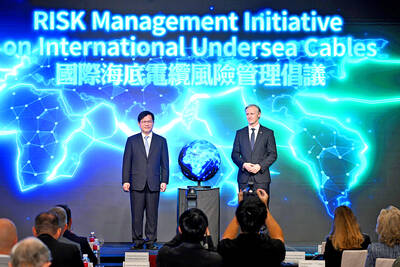An op-ed in the Chinese-language editions of People’s Daily and Global Times says there are no international waters in the South China Sea and that China should act with strength to repel US interference in the contested area.
In the article, which appeared last week, Pan Guoping (潘國平), a law professor at China’s Southwest University of Law and Politics, disputes the claim that the South China Sea comprises gonghai (公海), or “high seas,” as the term is translated in the UN Convention on the Law of the Sea (UNCLOS).
According to Article 86 of the convention, “high seas” refer to “all parts of the sea that are not included in the exclusive economic zone [EEZ], in the territorial sea or in the internal waters of a State, or in the archipelagic waters of an archipelagic State.”
By denying the presence of high seas in the South China Sea, China would deny freedom of navigation and use of airspace to other countries over the entire area, which Pan made clear.
“The United States is only a passer-by in the South [China] Sea ... As a country that has no sea coast in the region, does the United States have freedom of navigation and flight in the South [China] Sea? The answer is no! There is no international water in the South [China] Sea,” he wrote.
“China should act with stronger force ... to resolutely repel [US] interference, defend China’s nine-dotted line area that history has bestowed to us,” Pan wrote, referring to the large U-shaped swathe of territory claimed by China that encompasses most of the South China Sea.
Miles Yu wrote in the Washington Times that the article was “the clearest statement to date indicating the official Chinese Communist Party mouthpieces are specifically denying international freedom of navigation in one of the world’s busiest and most crucial waterways that China claims as its exclusive sovereign water.”
However, China analysts remain divided on the extent to which editorials appearing in official Chinese media truly reflect official policy in Beijing. Some have said that unless a piece appears in print, electronic articles appearing on the People’s Daily, the Global Times and Xinhua news agency Web sites are of variable influence and quality, and part of an internal debate rather than a statement of official policy. Pan’s article appeared in print in the international edition of the People’s Daily.
Sources close to Pan said he was “patriotic” and nationalistic on some international issues, but doubted his views on the South China Sea were “mainstream” among international law experts and Chinese government officials. It remains to be seen, therefore, whether Beijing has embraced a policy shift on the applicability of the “high seas” in the South China Sea.
An op-ed in Global Times in September warned of a “sea of fire” if claimants to islands in the South China Sea continued to oppose China’s claims.
Asked to comment on Pan’s article, the Ministry of Foreign Affairs in Taipei refused to go into detail, but reiterated the government’s long-held position that the Republic of China (ROC) has sovereignty over the region, that all claimants should set asides disputes and that the country would like to work with other countries to explore the region’s resources to jointly pursue peace and reciprocity.
James Tien (田中光), director-general of the ministry’s Department of East Asian and Pacific Affairs, said the ROC government’s assertion of sovereignty in the region was not in contradiction with US concerns over freedom of navigation.
“We are never opposed to freedom of navigation,” Tien said.
At the request of Chinese Nationalist Party (KMT) Legislator Herman Shuai (帥化民), a project to draw up and publish a new map of the South China Sea where the country has sovereignty is currently underway, Tien said.
Tien said the Ministry of the Interior would present a detailed report on the country’s territorial position and its line of reasoning after it completes the map.
The government bases its sovereignty claim on a map developed in 1947 using 11 interrupted lines drawn in a “U-shape” showing that the Spratly Islands (南沙群島), the Paracel Islands (西沙群島), the Macclesfield Bank (中沙群島) and the Pratas Islands (東沙群島) were within the territory of the country with reference to history, geography and international law.
Also last week, Major General Luo Yuan (羅援), a researcher at China’s Academy of Military Science of the People’s Liberation Army (PLA), said countries disputing China’s claims to the South China Sea would be making a mistake in interpreting Beijing’s “goodwill” and “self-restraint” for “softness” and “weakness.”
Countries that made such a mistake “can only get the opposite of what they wish for,” the South China Morning Post quoted the analyst as saying.
In a clear warning to what China sees as external interference in its backyard, Luo said Washington and Tokyo would only make things more complicated by getting involved in the overlapping claims over a series of islets in the South China Sea, which involves five of the 10 ASEAN member states as well as Taiwan.
These developments occured as Vietnamese Prime Minister Nguyen Tan Dung said for the first time on Friday that China had used military force to occupy the disputed Paracels in 1974.
China, he said, “used force to occupy all of the Hoang Sa [Paracel] Islands” in 1974, when the islands were jointly controlled by China and then-South Vietnam.
In related developments, the PLA said last week it had set up a strategic planning department as the army is rapidly modernizing to undertake more sophisticated operations.
The report, which appeared on the People’s Liberation Army Daily’s Web site, said the department, which will be administered by the General Staff Headquarters, will study critical strategic issues, draft plans and reform proposals for the PLA’s development, submit suggestions on the allocation of PLA strategic resources and examine and evaluate the implementation of PLA development plans.
Luo told the China Daily the move was in response to “increasingly sophisticated military operations in the future that might involve multiple combat forces and headquarters.”
“The new department will become an authoritative and comprehensive planning center,” Luo said.
Asked for comment, China watcher Gordon Chang (章家敦) expressed alarm at this development.
“Notice this is the same Luo Yuan who just threatened to use China’s military to enforce Beijing’s expansive claims to the entire South China Sea,” he told the Taipei Times.
“There are few coincidences when it comes to the PLA. They are planning to wage war and China’s flag officers are not shy in telling us how far they will go to achieve their objectives,” he said.
Additional reporting by Shih Hsiu-chuan

UKRAINE, NVIDIA: The US leader said the subject of Russia’s war had come up ‘very strongly,’ while Jenson Huang was hoping that the conversation was good Chinese President Xi Jinping (習近平) and US President Donald Trump had differing takes following their meeting in Busan, South Korea, yesterday. Xi said that the two sides should complete follow-up work as soon as possible to deliver tangible results that would provide “peace of mind” to China, the US and the rest of the world, while Trump hailed the “great success” of the talks. The two discussed trade, including a deal to reduce tariffs slapped on China for its role in the fentanyl trade, as well as cooperation in ending the war in Ukraine, among other issues, but they did not mention

Japanese Prime Minister Sanae Takaichi yesterday lavished US President Donald Trump with praise and vows of a “golden age” of ties on his visit to Tokyo, before inking a deal with Washington aimed at securing critical minerals. Takaichi — Japan’s first female prime minister — pulled out all the stops for Trump in her opening test on the international stage and even announced that she would nominate him for a Nobel Peace Prize, the White House said. Trump has become increasingly focused on the Nobel since his return to power in January and claims to have ended several conflicts around the world,

GLOBAL PROJECT: Underseas cables ‘are the nervous system of democratic connectivity,’ which is under stress, Member of the European Parliament Rihards Kols said The government yesterday launched an initiative to promote global cooperation on improved security of undersea cables, following reported disruptions of such cables near Taiwan and around the world. The Management Initiative on International Undersea Cables aims to “bring together stakeholders, align standards, promote best practices and turn shared concerns into beneficial cooperation,” Minister of Foreign Affairs Lin Chia-lung (林佳龍) said at a seminar in Taipei. The project would be known as “RISK,” an acronym for risk mitigation, information sharing, systemic reform and knowledge building, he said at the seminar, titled “Taiwan-Europe Subsea Cable Security Cooperation Forum.” Taiwan sits at a vital junction on

LONG-HELD POSITION: Washington has repeatedly and clearly reiterated its support for Taiwan and its long-term policy, the Ministry of Foreign Affairs said US Secretary of State Marco Rubio yesterday said that Taiwan should not be concerned about being used as a bargaining chip in the ongoing US-China trade talks. “I don’t think you’re going to see some trade deal where, if what people are worried about is, we’re going to get some trade deal or we’re going to get favorable treatment on trade in exchange for walking away from Taiwan,” Rubio told reporters aboard his airplane traveling between Israel and Qatar en route to Asia. “No one is contemplating that,” Reuters quoted Rubio as saying. A US Treasury spokesman yesterday told reporters